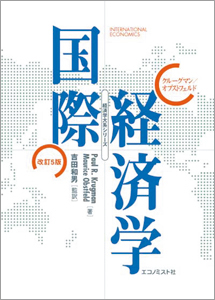|
|
|
 |
|
|
 |
クルーグマン 国際経済学 [改定5版]
Paul R. Krugman 他著
吉田和男 監訳
A5判 1,056頁
¥10,479
|
|
|
本書は世界的に著名な経済学者であるポール・クルーグマン(Paul R. Kruguman)MIT教授とマウライス・オブストフェルド(Maurice Obstfeld)カリフォルニア大学教授の共著によるInternational Economics Theory and Policy Addison Wesley Longman,Inc.の翻訳である。本書は世界的に定評のある国際経済論の教科書であり、最も優れた教科書である。しかも、国際貿易と国際金融の両面に十分な目配りをしており、国際的な経済取引に関する経済分析を網羅している。これほど完璧に国際経済学の分野を網羅している教科書は見あたらない。逆に、そのために日本語版は1,000ページを超える非常に分厚いものになっている。
また、本書は国際経済学に関する伝統的な理論、諸制度を丁寧に解説しており、はじめて国際経済論を勉強する学生社会人にとって最適な教科書である。そして、多くの例を示して、これでもかこれでもかと読者に分からせようとする。その熱心な姿勢には感服する。
前半部分はいわゆる貿易理論であり、リカード以来の伝統的な比較生産費理論から始まる比較優位の理論を広範に紹介し、最近の研究の成果である収穫逓増にかかる理論、異時点間貿易論などに至るまで緻密にフォローされている。収穫逓増、不完全競争と貿易との関係に関しても産業内貿易、ダンピング、外部経済、動学的収穫逓増など多くの話題に論究しており、現実の貿易問題を理解するのに多くの経済学の議論を紹介している。そして、自由貿易に関する論争、開発途上国との貿易問題、戦略的貿易政策に関する説明など現実の貿易政策問題を取り上げて、国家政策との関係に論究している点も重要である。「自由貿易の国はほとんど存在しない」と言う記述は印象的である。日本の貿易政策に関しても論究されているが、アメリカでの日本の貿易政策に関する多くの論調に対して、非常にフェアーな見方を要求している。
後半部はいわゆる国際金融にかかる分野である。まず、為替レートの決定に関する経済理論をまとめ、特に購買力平価説、フロー・アプローチ、マネタリー・アプローチといった多くの教科書にあるものに加えて、近年研究の進んできたアセット・アプローチに関する丁寧な記述がある。ともかくこの話は説明が難しい。国際的な経済取引を含んでマクロ経済問題を考える国際マクロ経済学に関して多くのページが割かれている。今日の経済学の主テーマであるマクロ経済学は閉鎖経済を前提として議論されることが少なくない。しかし、1970年代の変動相場制度への移行に伴い、各国のマクロ経済の問題も国際金融を無視して議論できなくなった。財政金融政策の有効性に関するマンデル=フレミングの提起した問題に始まり、複雑な国際金融取引がむしろ国内経済を規定するという事態となる。
国際金融は国際間の協定により「制度」が定められ、それに従って運営されている。さらに、国内の経済政策が直接的に為替レートに影響を与えるので政策協調が求められることになる。この様な国際的な枠組みに関しても本書は丁寧に解説されており行き届いたものになっている。
この様に、本書の特徴として、各国の経済・貿易・金融の現実に関して結構細かい解説が多く行われており、現実の問題対する理解や政策について十分に配慮されている点である。経済学の入門的な教科書の多くはこれまで議論されてきた経済理論を羅列することで終わらしているものが少なくないのに対して、現実の問題をその意味でも、大学で教科書として読者の対象とされる学生だけでなく、社会人にも是非読んでもらいたいものである。分量が多いだけにこれを読み終えるのはなかなか大変ではあるが、時間をかけて読むに十分値打ちのある教科書である。
「国際経済学」[改定新版] について
International Economics, the best-selling textbook in the field, is written by two of the world's preeminent economists. Both the real trade portion of the book and the monetary portion are divided into a core of chapters focused on theory, followed by chapters applying the theory to major policy questions, past and current.
International Economics presents an integrated treatment of Ricardian, specific factors, factor endowments, and imperfect competition models of trade, along with in-depth analysis of empirical evidence. It covers the effects and causes of trade policy, including strategic trade policy, focusing on the income-distribution effects of trade. The book provides a unified model of open-economy macroeconomics based on an asset-market approach to exchange rate determination with a central role for expectations.
The new edition contains updated coverage of the euro and of the causes and likely effects of economic and monetary union (EMU) in Europe. It also features an up-to-date treatment of developing countries' experiences in an all-new Chapter 22. The chapter focuses on long-run income convergence, disinflation and exchange rate regimes, recent crises in Latin America, Russia, and Asia, and reform of the international financial "architecture."
[改定新版]で全く新たに収められた内容:
NEW! Extensively revised Chapter 20 on how EMU was attained, the institutional
structure of monetary policy in EMU, and the major policy problems that are now
coming into focus.
NEW! All-new Chapter 22 on the issues of long-run growth and convergence in
developing countries, reform and liberalization, macroeconomic stabilization,
exchange rate regimes, and redesign of the international financial "architecture."
NEW! Updating of the text throughout to maintain current relevance. For example, see discussion of the "mystery of the missing trade" in empirical assessment of the Heckscher-Ohlin model in Chapter 4, and analysis of the effect of Korea's 1998 won devaluation on its trade balance in Chapter 16.
Extensive use of case studies, special boxed examples, and chapter appendixes.
Many new international (non-U.S.) examples throughout.
NEW! All-new Web site featuring a wealth of resources for instructors and students.
目 次
1.Introduction.
I.INTERNATIONAL TRADE THEORY.
2.Labor Productivity and Comparative Advantage: The Ricardian Model.
3.Specific Factors and Income Distribution.
4.Resources and Trade: The Heckscher-Ohlin Model.
5.The Standard Trade Model.
6.Economies of Scale, Imperfect Competition, and International Trade.
7.International Factor Movements.
II.INTERNATIONAL TRADE POLICY.
8.The Instruments of Trade Policy.
9.The Political Economy of Trade Policy.
10.Trade Policy in Developing Countries.
11.Strategic Trade Policies in Advanced Countries.
III.EXCHANGE RATES AND OPEN-ECONOMY MACROECONOMICS.
12.National Income Accounting and the Balance of Payments.
13.Exchange Rates and the Foreign Exchange Market: An Asset.
14.Money, Interest Rates, and Exchange Rates.
15.Price Levels and the Exchange Rate in the Long Run.
16.Output and the Exchange Rate in the Short Run.
17.Fixed Exchange Rates and Foreign Exchange Intervention.
IV.INTERNATIONAL MACROECONOMIC POLICY.
18.The International Monetary System, 1870-1973.
19.Macroeconomic Policy and Coordination Under Floating Exchange Rates.
20.Optimum Currency Areas and The European Experience.
21.The Global Capital Market: Performance and Policy Problems.
22.Developing Countries: Growth, Crisis, and Reform.
|
|
|
|

